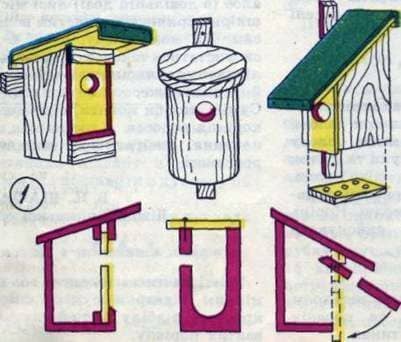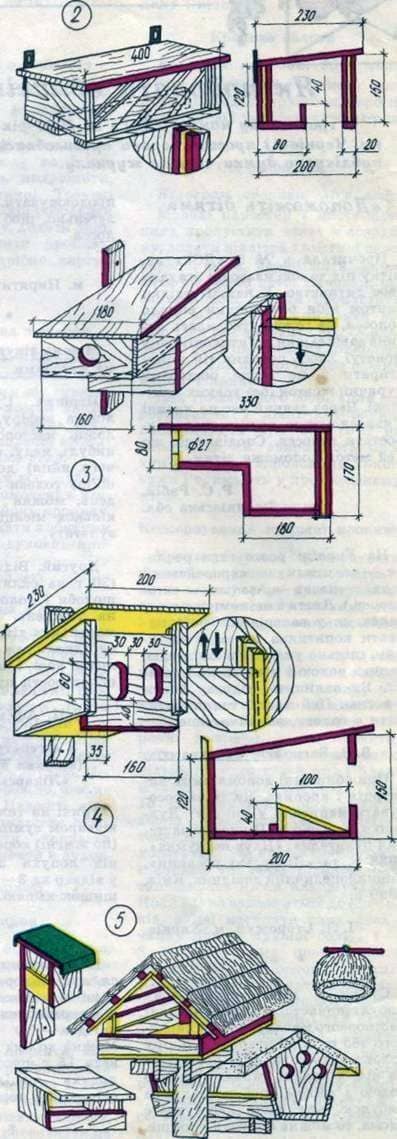A birdhouse in the garden

Scientists estimated that a large titmole per day flies to the nest with food for chicks more than 350 times, and a gray flycatcher and some other small insectivorous birds – over 400. For 14-16 days, when a yellow-headed baby is in the nest, a large titmouse brings in more than 2 kg of different insects, among which pests predominate. In general, a pair of these birds during the nesting period completely releases about 40 fruit trees from insects.
Studying the food grumbling, it was calculated that in five days the chicks of one nest had eaten 796 May May beetles, 160 of their larvae and 39 other harmful insects. During the nesting period, the family of starlings destroyed over 7800 May May beetles and their larvae.
One of the important ways to protect and attract birds is to hang artificial nests. The most common and well-known among the people is a birdhouse. The boarded nests are made of boards 1.5-2.5 cm thick. They must be rough (not planed), so the birdie clings better to the wall of the house on both sides. Through this, do not use plywood, different plastics.
Make a birdhouse in the form of a box with a square bottom and equal to the height of the walls. The roof is better to do in width equal to the outer width of the nest and without tilting. The rear part of the roof should pass along with the rear outer wall, and only in front, above the tap, the roof can protrude outward by 2-3 cm, and no more.
Summer – round hole – cut out 2-3 cm from the top edge of the front wall of the nest. The square tapholes in the sipes are made by cutting one of the upper corners of the nest wall.
It should be remembered that no plates or brusochkov from outside under the lock must not be fastened. Birds do not need them, and it is easier for predators to pull chicks out of the nest.
When making houses, crevices are sometimes formed. On small (width up

Boxes should be well ventilated, conveniently opened for cleansing in the autumn, eliminating unwanted nests, etc. Therefore, the walls (rarely the roof) are made mobile. Sometimes the front and rear walls are made of glass, and the birds fly into the nest at the bottom.
Of particular importance is the diameter of the opening of the nest: at 27 mm only small species of birds can penetrate into the feeder, and at 34 mm large (a large bird, a sparrow). The base of the box is 120X120 mm, and the height is 200 mm. For rare species of forest owls, the substrate should be 300X300 mm, height – 400 mm, and the hole diameter – 130 mm.
For the production of boxes use externally trimmed boards with a thickness of 20 mm. The corners of the sides of the boxes are straight, untidy. The boards are knocked down with nails, preliminarily immersed in oil-based putty. The roof is covered with tarry or aluminum tin, the walls – with oil paint. The hole is left untreated. To ventilate the nests from below, drill holes with a diameter of 6 mm.
In Fig. 3 depicts a box for birds, which hatch the young in hollows (the rear wall is retractable), and in Fig. 4 – in niches of trees (front wall movable). Such nest designs particularly reliably protect birds from their enemies. However, they are more difficult to manufacture.
Boxes nailed, hung on knots, tied with a wire, etc. If necessary, create additional protection for birds from the wire mesh. Boxes should be tilted slightly forward so that rain does not penetrate into the hole. The direction of the hole is east or southeast.
Feeders can be arranged on poles, balconies, walls or windows. It is especially important that in the winter there is always dry food, and cats could not penetrate to the feeding troughs.
A birdhouse in the garden

